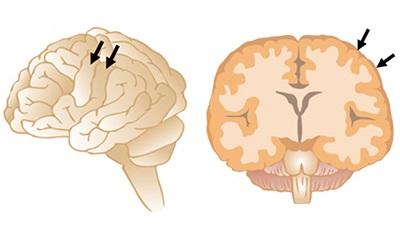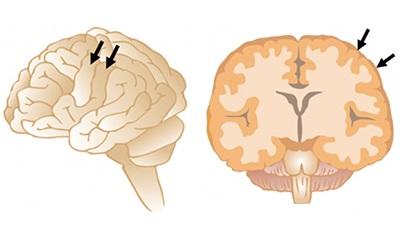
Credit: Kanazawa University
[Background]
The human brain is highly developed compared to other animals, thanks to which humans are believed to have acquired special abilities. One of the important factors considered to contribute to the development of the brain is the gyrus*1), the fold of the surface of the cerebral cortex*2).
The cerebral cortex is particularly important in higher brain functions. The cerebral cortex of higher animals, including humans, has many folds, called the gyrus (plural: "gyri") (Figure 1). Because of the gyrus, it has become possible for the brain of higher animals to have a large number of neurons, and thus great development of brain functions has been acquired. On the other hand, the mouse, a widely used model animal, has a brain without gyri. This has made it very difficult to do research on the gyrus using the mouse as a model animal; therefore, research on the gyrus has been much retarded.
A research group at Kanazawa University, Japan, has been using the ferret*3), a higher mammal, that has a brain more similar to the human brain than that of the mouse. The ferret brain is known to have gyri, but research techniques for the ferret brain were not well developed. The research group developed a technique for the ferret brain, which allows analysis of ferrets at the genome level, and reported the results using that technique in 2012 and 2013. Thus, this group is a world leader in molecular biological research using the brain of higher mammals, and by using this technique, for example, they succeeded in developing a ferret disease model that shows impairment in gyrus formation. In the present study, using their technique, they have identified a signaling pathway that plays important roles in gyrus formation in the cerebral cortex of higher mammals.
[Results]
The Kanazawa University group has investigated mechanisms involved in gyrus formation during early ferret cerebral cortex development, and identified for the first time that FGF signaling*4) is important in gyrus formation. More specifically, 4 observations have been made.
- Expression of FGF receptors*5) is augmented where gyrus formation is about to take place. Examination of tissue sections*6) of various cerebral cortex regions that express FGF receptors indicated that regions destined to form gyri expressed more FGF receptors than other regions. This result suggests the possibility that FGF receptors mediate gyrus formation.
- When FGF signaling is inhibited, gyrus formation is impaired. In order to verify the above possibility, FGF signaling in the ferret brain was inhibited by using the technique previously developed by the research group. As expected, gyrus formation was impaired (Figure 2). This result indicates that FGF signaling is important for gyrus formation.
- Inhibition of FGF signaling reduces neural progenitors*7). They investigated what would happen in the cerebral cortex where gyrus formation was impaired due to the inhibition of FGF signaling, and found that neural progenitors that produce neurons in the cerebral cortex were much reduced in number (Figure 3).
- Inhibition of FGF signaling reduces the number of neurons in the cerebral cortex. Since the reduction was observed in the number of neural progenitors that produce neurons in the cerebral cortex, they next investigated the number of neurons and found that in the superficial layer of the cerebral cortex where FGF signaling was inhibited was particularly reduced in comparison to other layers.
In summary, it is concluded that FGF signaling augments the number of neuronal progenitors and neurons in regions destined to become gyri, and, as a result, gyri, folds of the cerebral cortex, are formed (Figure 3).
[Significance and future prospects]
In the present study, the authors uncovered an important mechanism of gyrus formation in the cerebral cortex by using their unique research technique developed for the ferret. In the past, there have been few studies on the mechanisms of gyrus formation with animal models, so the present study is truly world leading. As mentioned above, the research group succeeded in 2015 in developing a ferret disease model that shows impairment in the gyrus.
It is expected that further studies along these lines should contribute to research on brain evolution, up to that of the human, which has been difficult in the past, and to the investigation of causes and treatment of various diseases of the brain and the nervous system.
[Glossary]
- *Gyrus
The fold (protrusion) of the cerebral cortex surface. Folds permit the cerebral cortex to have a large surface area, which in turn allows accommodation of a large number of neurons in the cerebral cortex. The mouse brain does not have gyri, while the brains of humans, monkeys and ferrets, higher animals than the mouse, do have gyri. It is therefore thought that the gyrus is important for the development of higher brain functions. - *Cerebral cortex
The surface region of the brain. The human cerebral cortex is especially well developed in comparison with that of other animals, so it is thought to be important for higher brain functions. Impairment of the cerebral cortex is considered to cause various neurological diseases and psychiatric disorders. It is one of the most important regions of the brain and attracts much attention in brain research. - *Ferret
A higher mammal akin to the weasel. The ferret has a more developed brain than the mouse and has gyri. Hence, the ferret was used as a model animal in the present study for bringing about the results described above. Few genetic studies have been done on the ferret brain; brain research using the ferret is one of the specialties of the research group. - *Fibroblast growth factor (FGF) signaling
FGF induces activation of this signaling in cells. FGF signaling is known to play essential roles in development, differentiation and proliferation of tissues. - *FGF receptor
FGF receptors are protein molecules on the cell surface that bind extracellular FGF. They act like antennae to bind FGF, and FGF binding to FGF receptors turns on FGF signaling (switch-on state). - *Tissue section
Tissue section is a tissue slice with the thickness of 10 to 50 μm. Tissue sections are used to investigate the structure of tissues and organs. - *Neural progenitor
Neural progenitors are the cells that produce neurons during fetal brain development. Neural progenitors proliferate to be larger in number and then differentiate into neurons.
###
Media Contact
Fujiko Imanaga
[email protected]
81-762-645-977
http://www.kanazawa-u.ac.jp/e/index.html
Related Journal Article
http://dx.doi.org/10.7554/eLife.29285





